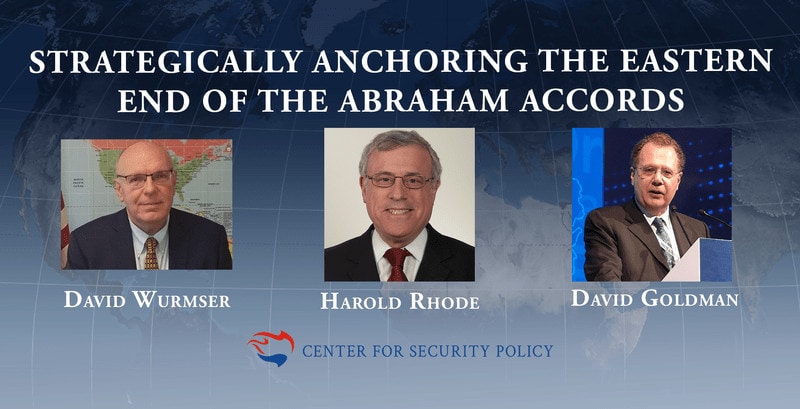Webinar: Strategically Anchoring the Eastern End of the Abraham Accords

On February 3, CSP hosted a webinar in which three scholars — Harold Rhode, David Goldman and David Wurmser — discussed the southwest Asian strategic context of the Abraham Accords as more than just a peace treaty. Bahrain, Israel and the UAE have laid the foundation of a larger strategic alliance.
The accords emanate from the regional perception that Israel is rising as a powerful strategic player in and of itself in the Levant rather than just being a vassal of the United States. In an era either of American withdrawal from the region or escalated efforts by the United States to reach diplomatic agreements with some of the region’s most determined adversaries, the value of harnessing Israel to anchor a strategic bloc actually increases for Arab states potentially abandoned by a straying United States.
Strategically, the accords offer a structure to answer not only the acute threat posed by Iran’s revolutionary regime, but also by the long-term threat posed by a rising, aggressive and destabilizing Turkish regime and the opening it offers to China. President Erdogan of Turkey has already acted upon this new reality both symbolically – by prioritizing the distribution of the COVID-19 Chinese vaccine in Turkey – and practically – by turning over the modernization of Turkey’s telecom industry’s upgrade to 5G to China, as well as striving to become the region’s first cashless society using Chinese technology.
From the Chinese perspective, the Turkish orbit, which includes Pakistan and other central Asian countries, can be naturally aligned with Iran despite their historical rivalry. China sees all of them as failed, collapsed empires that need Beijing’s help to survive and thus can be welded to a Chinese-sponsored axis based on Pax Sinica to encircle India and extend China’s reach to the Mediterranean.[1] It is true that these nations all represent potential threats to China – as seen when Turkey early on criticized China over its oppression of Uyghurs, although later became silent, if not even indulgent, of this oppression. Still, China embraces the adage that one must keep one’s allies close, but one’s enemies even closer.
The other powerful player on the eastern end of the Abraham Accords is India, which finds itself increasingly besieged by this Turkish-Chinese alliance. The election of Imre Khan, who is aligned with the Muslim Brotherhood over which President Erdogan asserts leadership, has offered Turkey an opportunity. Erdogan is using and inciting the Pakistan-India conflict, and the warming ties between the UAE, Saudi Arabia and India, to wrench Pakistan out of the Saudi-UAE orbit into the Turkish orbit – even on the level of potential nuclear access – in its struggle to control the Sunni world as a modern Khaliph. To this end, he is using government agencies, family foundations, charities, and other structures to work through Pakistan’s ISI to organize, indoctrinate and support not only Kashmiri Islamist separatists, but to radicalize India’s 200 million Muslims, thus posing an existential threat to New Delhi. This threat has forced New Delhi, even during its hot conflict with China, to both support Armenia and surge intelligence assets to track the subversive activity of these Turkish organizations and governmental bodies.
Including India in this rising strategic bloc anchored to Bahrain, Israel and the UAE also helps refine the bloc’s larger geopolitical orientation as an appropriate answer to the strategic alignment of China and Turkey. Currently, there is some murkiness in Manama’s, Jerusalem’s and Abu Dhabi’s approach to China which can thus be clarified.
Were Iran to enter a post-revolutionary era, it would release Gulf Sunni Arabs and Israel to focus on addressing the most dangerous, internal Sunni threat posed by Turkey and stall Erdogan’s imperial ambitions to reestablish control over lost Ottoman provinces and turn the eastern Mediterranean into a neo-Ottoman lake. Along with the natural historical and cultural affinities between India and Iran, this offers the potential for establishing a powerful, free-standing block anchored to the Abraham accords – which is aligned with the United States but not dependent on it — that stretches from India (and potentially Japan and other Asian lands) all the way over to Greece and Cyprus (and potentially beyond) on the other end.
[1] David Goldman (Spengler) discusses this insight in further depth on his February 3, 2020 article in Asia Times, “A Pax Sinica takes shape in the Middle East.” See: “https://asiatimes.com/2021/02/a-pax-sinica-takes-shape-in-the-middle-east/
- Saudi Crown Prince’s Visit Restored an Important Relationship: Dr. Wurmser - November 24, 2025
- The Dick Cheney I Knew - November 5, 2025
- “His intellect, image, and integrity made him such a convincing figure”: Dr. Wurmser on Dick Cheney - November 4, 2025
